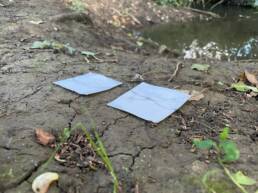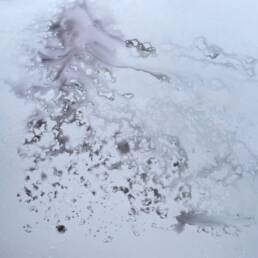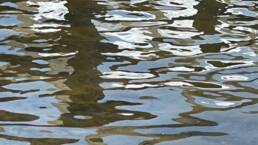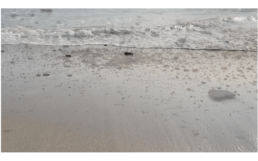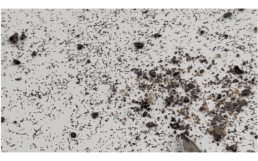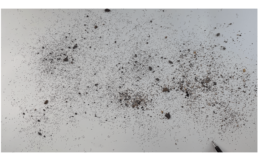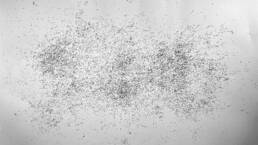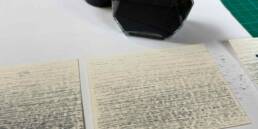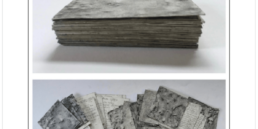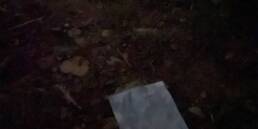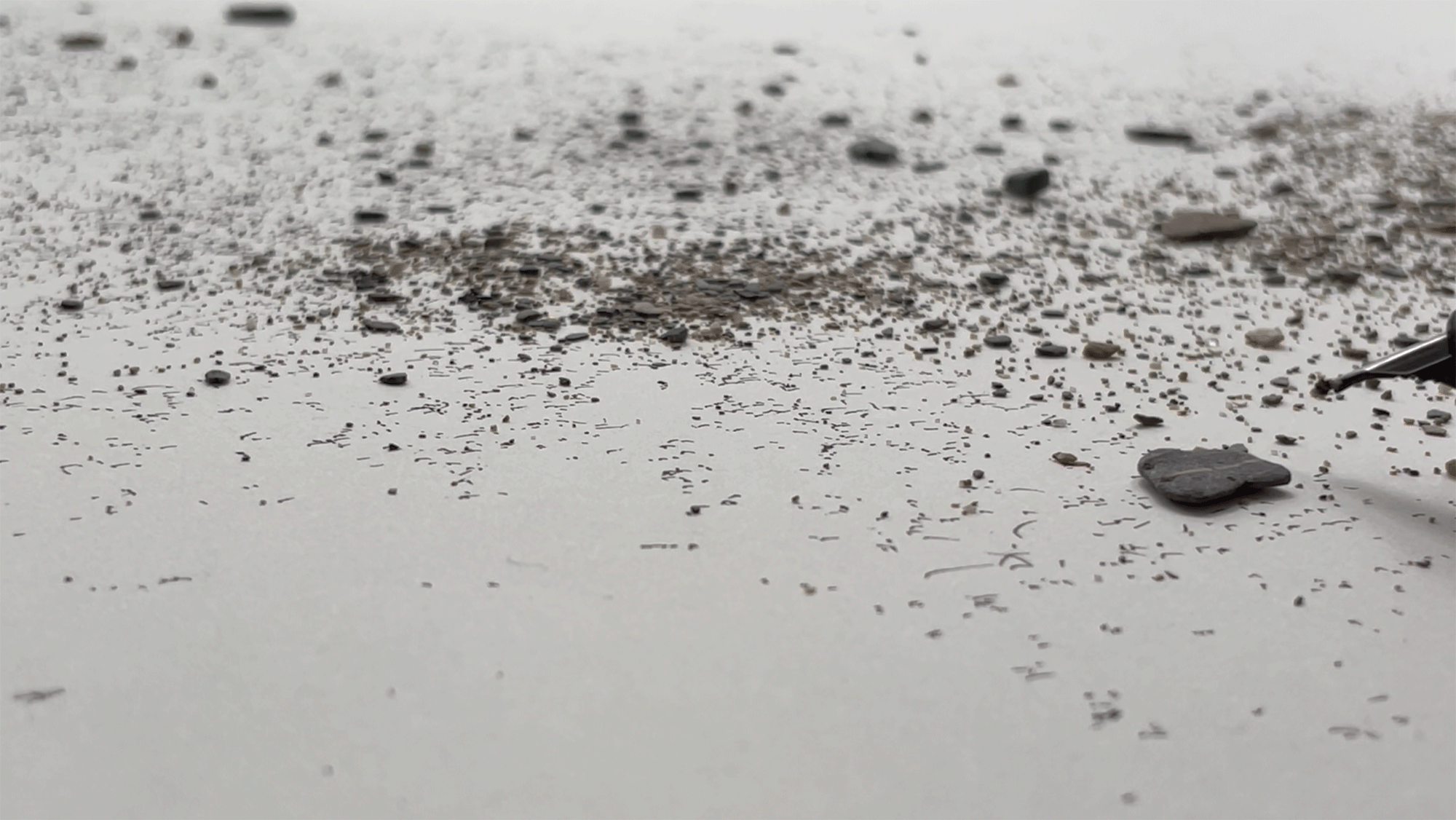
watermarks, tide, drawing and mapping water
Thoughts on recent works, ‘Watermarks, From the Water’s Edge’ (Walking The Land) and TIDE (video and drawings), with reflections on water and creative counter-mapping in my work.
Returning home from a trip to the coast, I continued to experiment with sea water, sand, ink and paper. Enjoying the playful pinging of the sand on paper when my pen came into contact, I recorded the traces of its movement. Catching each grain of sand, my movements inspired by tides, reminded me of pick-up-sticks and childhood games. So often it is accidental play that leads me into a new body of work. The process of making and thinking whilst making, leads into new works, research, serendipitous encounters, and generates new meanings and associations that expand beyond its beginnings.
After months of seeking out the edges of water, it was finally the dance of sand and pen on paper that became a new work, T I D E, and my response to ‘Watermarks, From the Water’s Edge’. A group of us at Walking The Land were each making a work for a video assemblage to be screened at The Edge Conference 2021, University of the Highlands and Islands.
T I D E came about as result of seeking out the edges of water, walking, pausing, watching, listening; letting my creative responses be led by the water itself. I documented water both still and moving, and tried to capture the way it can shift and repeat shapes, form and colours. From the surface of the water to the edges, I stood besides as well as in the water, using different angles, above to within, moving between video, photography and drawing, often using materials found in situ. I created drawings in the rain, wind, sun and then back in the studio.
Throughout this time, I was in a virtual conversation with other artists from Walking the Land, regularly sharing our responses, thoughts and ideas on the prompt of ‘Watermarks, From the Water’s Edge’. To help link all the videos as an assemblage, we each selected a word for our work:
abovebelow · bleeding · bridge · control · dowsing · futureflooding · home · insideland · migration · overlap · peixe · precarious · reflections · source · tide · vestiges
Inevitably in a collaborative project like this, it requires trust in both the process and each other and creating a work as part of a whole, without knowing exactly what the end result will be. Watching the video assemblage and the flow of watermarks through each of our works has created new resonances and conversations which will be fed into The Edge Conference panel discussion and will no doubt generate thoughts for future projects too.
T I D E (2021, video still images)
Water is increasingly featuring in my art. This need for water was heightened during lockdown when access was limited and I missed being able to swim in sea and rivers. Puddle Worlds, created from a small garden puddle, had a map-like connection to the elements and to imaginary worlds of seas, lakes, rivers and land, and gave me somewhere to travel to in my imagination.
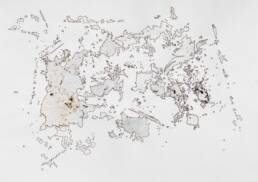
Tuning into a place in a sensory way, or through memories and imagination, is integral to many of my works. 11 Tracks, A Line Across England, Groundlines, all involve pauses on a journey to engage with the surface of the ground, with materials, elements, and imagining what might lie beneath the surface of a track in the landscape, its history, people, wildlife, its story and possible future. In contrast, works such as T I D E , are created retrospectively in the studio, travelling in my imagination to memories of place, of elements, and environment. The abstract marks on the paper are mapping and choreographing my conversation with the elements, standing by the water’s edge, my feet in the sand, feeling the tide move in and out, the sand and sea shift. The sand is as much the drawing material as the pen and directs its flow; an elemental dance.
At times I listened to watery recordings whilst drawing, including some recent talks and interviews by Meeting Oceania. These drew me into the global and cultural world of water; from sand, rivers and indigenous communities in Australia and around the world, to mapping places, the rights and ethics of bodies of water, and ways of tuning into, communicating with, and being at one with our environment.
I also became increasingly aware of the presence of mapping and counter-mapping in some of the sensory processes and visual outcomes of my work. This has led me to connect with RMIT (Melbourne) and their work on ‘Climate of Change: creative counter mapping methods for sensing place’. Having just made T I D E, I was intrigued when I heard Linda Knight discuss the concept of inefficient mapping as a way of making or reaffirming our connection to place and environments, often gesturally rather than representationally. Indigenous traditions for mapping place have been overshadowed by the modern power-driven need to efficiently map a place. It was as if I had stumbled across a potential methodological and theoretical context within which to articulate (and validate) the processes behind the making of works such as T I D E and its scribble-like outcomes.
T I D E (2021), video and drawings by Ruth Broadbent
Pen on paper with trace memories of sand, sea, tide
This video was shown as part of ‘Watermarks’, a Walking The Land video assemblage, screened at The Edge Conference 2021, University of the Highlands and Islands.
To watch T I D E, click on above image or watch on Vimeo or YouTube.
References:
Linda Knight – Inefficient Mapping: A Protocol for Attuning to Phenomena (punctum books, 2021)
Meeting Oceania (see link to YouTube channel on their website)
The Edge Conference 2021, University of the Highlands and Islands, an online event 16-17 December 2021. Watermarks screening and panel discussion is scheduled for 16 Dec in the afternoon.
The Watermarks video assemblage by Walking The Land can be watched here.
The Watermarks panel discussion at The Edge Conference can be watched here.
Watermarks:
Janette Kerr / abovebelow
Julius Smit / bleeding
Tom Keating / bridge
David Tidsall / control
Gillian Cooper / dowsing
Carolyn Black / futureflooding
Charlotte Rooney / home
Linda Ingham / insideland
Rachel McDonnell / migration
Andy Freedman / overlap
Suze Adams / peixe
Tamsin Grainger / precarious
Kel Portman / reflections
Richard Keating / source
Ruth Broadbent / tide
Caroline Morris / vestiges
